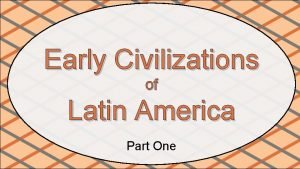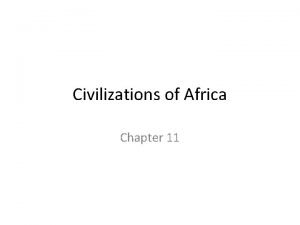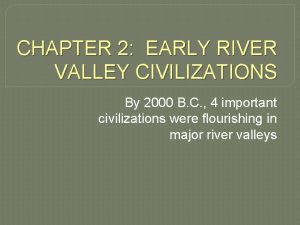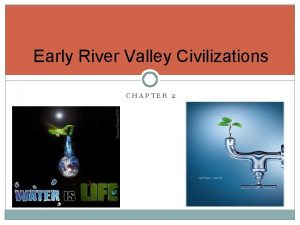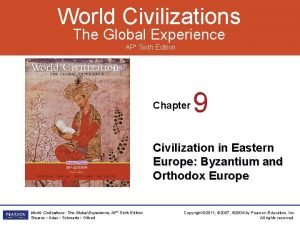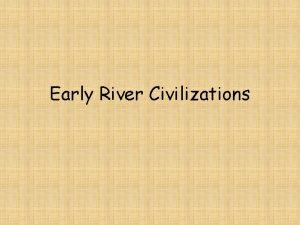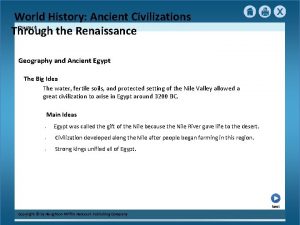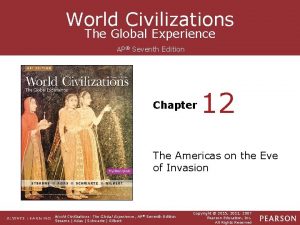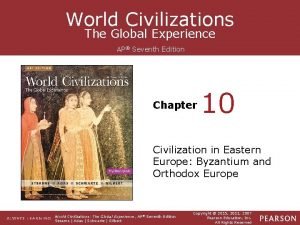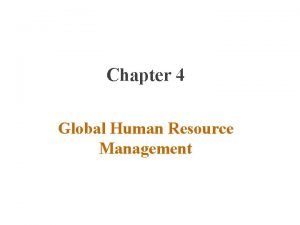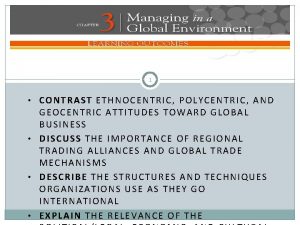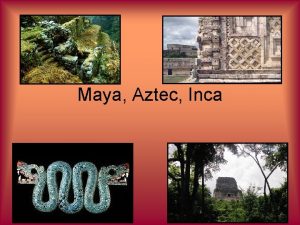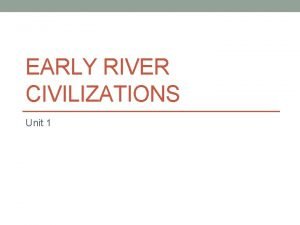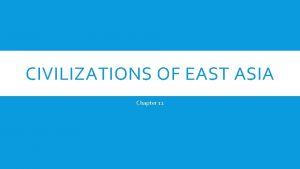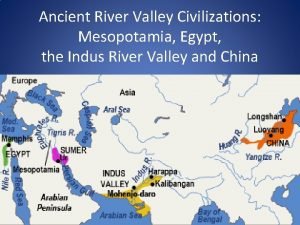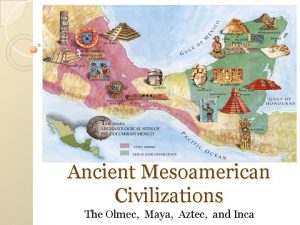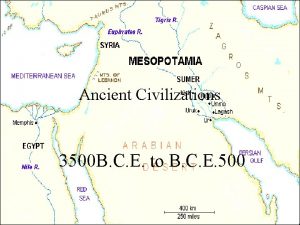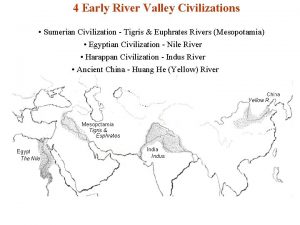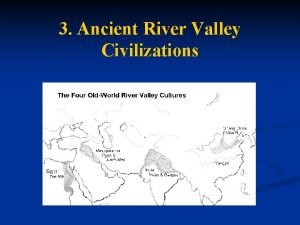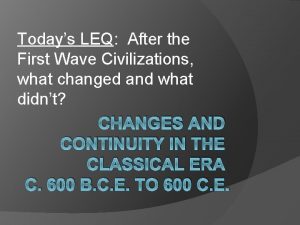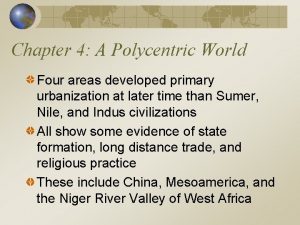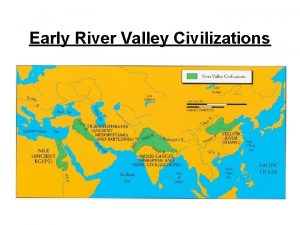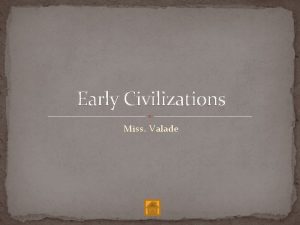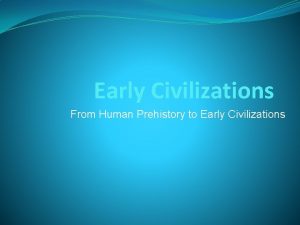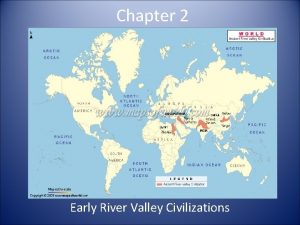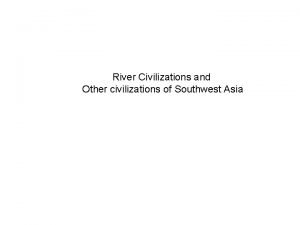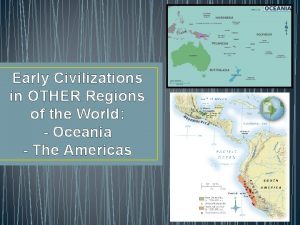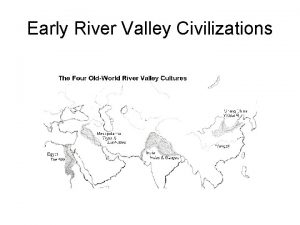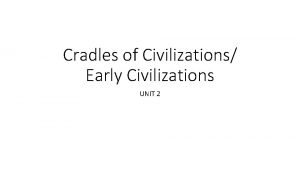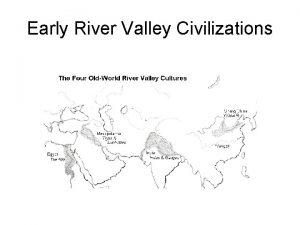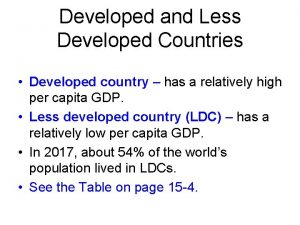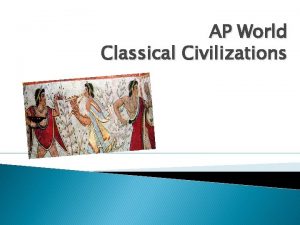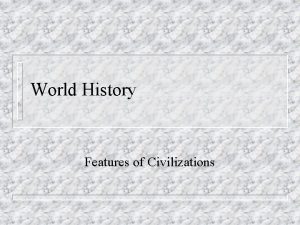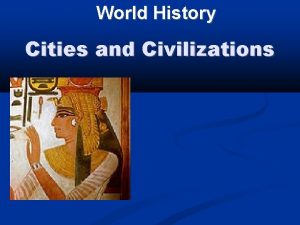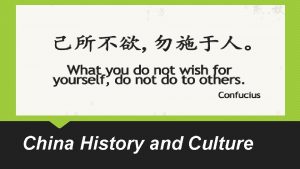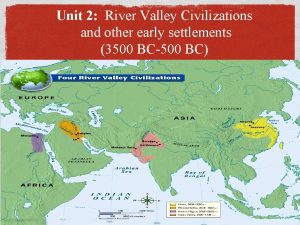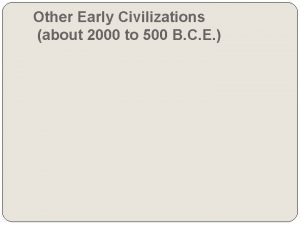Other Early Civilizations A Polycentric World n Developed


































- Slides: 34

Other Early Civilizations

A Polycentric World n Developed urbanization at later time than Sumer, Nile, and Indus civilizations n All show some evidence of state formation, long distance trade, and religious practice n These include China, Mesoamerica, and the Niger River Valley of West Africa

China: The Xia, Shang, and Zhou n. The three dynasties may have coexisted n. Capital cities shifted frequently n. Dynasties were wealthy and controlled large work gangs

Geography n Huang He (Yellow River) and Chiang Jiang (Yangtze) rivers flood quite often.

n Early Evidence of Writing n. Oracle bones were basis of early writing n. Cracks in heated bones were basis of predictions of the future or communications with the gods


Xia Dynasty (Approx. 4000 yrs ago) n Has long been regarded as a mythical dynasty n Need to control Yellow River flooding required development of large labor gangs n Produced carved jade, bronze weapons, and pictograms [forerunners of written script]

Shang Dynasty (1750 -1122 B. C. ) n Shang ruler controlled network of cities from his capital city n Relatives controlled other cities, represented interests of king and shared local harvests n Shang ultimately controlled 40, 000 square miles n Ongoing conflicts at edges of territory

Zhou Dynasty (1122 -256 B. C. ) n Ancestor Worship n claimed the Mandate of Heaven n Linguistic unity – Mandarin was standardized n Trade expanded to distant regions

The Zhou n Zhou reduced Shang to small warring power n Produced written records n Book of Songs a collection of ancient poetry n Transformed warfare to cavalry and infantry n End of Zhou known as era of Warring States

America

Mesoamerica and South America n Early cities were religious shrine centers linked by shamans to world of spirits n Cities built on lakes, not river systems n Work was more labor-intensive n No writing system except for Maya n These civilizations had foot in Stone Age

n Humans entered the Americas 15, 000 years ago n Developed maize by 5000 B. C. E. and beans and gourds by 3000 B. C. E. n Valley of Mexico and high Andes of Peru centers of civilization



Olmecs – 1500 BCE-400 BCE n produced hieroglyphics, and sculpture n Stone and jade was moved to La Venta from a great distance n Reason for Olmec’s decline unknown; Lasted till 400 B. C. E.

Mayans 2000 BCE- 900 CE n Represented true urban revolution Teotihuacan n Peak was 550 C. E. with 100, 000 residents n Strategic location on the Yucatan peninsula n Center of extensive trading network n City dominated by pyramid situated above ancient cave with religious significance n Sacrifices and elaborate burials

n pyramid and temple emphasize religious importance of Teotihuacan n Regular layout of city shows power of government n City burned down in 650 C. E. and civilization vanished within a hundred years


Mayan n. Suspected reasons for decline include population pressure, climate change, warfare, pressure on resources n. Few Mayan cities remained to greet Spanish arrival

Zapotec 1400 bce – 900 ce n Zapotec Civilization in Oaxaca Valley n Reached peak by 200 C. E. n Religious symbolism present in temples and pyramids n. No central city but based on 2, 000 terraces scattered across fifteen square miles

South America n Urbanization in the Andes Mountains n Trade networks connected mountains and coast n Chavin are first known Andean civilization n Irrigated high plains and established religious ritual and administrative practices that were preserved by successor states


n The Nazca n Forerunners of the Inca in Peru n Around 600 bc they disappear n No one is quite sure why they create the “Nazca Lines”



A note about North America… n Agricultural Towns in North America n Few urban traits n Towns in southwest influenced by Mexico n First fully developed towns comprised mound builders along Mississippi River at Cahokia n All North American towns were in decline before arrival of Europeans

Africa – Niger River Civilization

The Niger River Valley n Until 1970 s, all sub-Saharan towns were seen as derivatives of outside examples (historical interpretation) n City development a result of trade with others n New evidence challenges idea of lack of innovative urban centers in west Africa n Region jumped from stone to iron ages with few examples of bronze artifacts

n Jenne-Jeno n First known indigenous city in Sub-Sahara n City developed 400 C. E. and peaked 900 C. E. n Central area was a walled city containing eighty acres n Were probably ancestor worshippers n West African cities may have predated outside influences n In decline by 1100 C. E.

The Niger River Valley n State Formation? n Jenne-jeno may have been a collection of independent cities without central control n May have been a cooperative society with relative equality rather than organized by competition, dominance, and coercion n Alternate reasoning suggests Jennejeno may have developed only to level of Olmecs in Mexico

• Trade Across the Sahara • Gold, hardwoods and slaves • Linked Asian and African Cultures

Bantu migrations carry knowledge of iron working and settled agriculture

Bantu Migrations: 1000 BCE To 500 CE
 Early south american civilizations
Early south american civilizations Chapter 9 lesson 1 early civilizations
Chapter 9 lesson 1 early civilizations Chapter 11 section 1 early civilizations of africa
Chapter 11 section 1 early civilizations of africa Cahokia apush definition
Cahokia apush definition River valley civilizations def
River valley civilizations def Lesson 1 early civilizations
Lesson 1 early civilizations Unit 3 lesson 1 sumer and mesopotamia
Unit 3 lesson 1 sumer and mesopotamia Chapter 2 early river valley civilizations
Chapter 2 early river valley civilizations World civilizations the global experience ap edition
World civilizations the global experience ap edition World civilizations the global experience 7th edition
World civilizations the global experience 7th edition River valley civilizations map
River valley civilizations map Ancient civilizations through the renaissance
Ancient civilizations through the renaissance Twantinsuyu
Twantinsuyu World civilizations the global experience 7th edition
World civilizations the global experience 7th edition Early cpr and early defibrillation can: *
Early cpr and early defibrillation can: * Types of position
Types of position Polycentric governance
Polycentric governance Eprg model
Eprg model Eprg model
Eprg model Regiocentric approach advantages and disadvantages
Regiocentric approach advantages and disadvantages Human resource management activities
Human resource management activities Geocentric attitude
Geocentric attitude Dünya odaklı yönelimin kısıtları
Dünya odaklı yönelimin kısıtları Polycentric chromosome
Polycentric chromosome Managing in a global environment
Managing in a global environment Inca mayan and aztec map
Inca mayan and aztec map Map of river valley civilizations
Map of river valley civilizations Ancient river valleys map
Ancient river valleys map Lesson quiz 11-3 civilizations of east asia
Lesson quiz 11-3 civilizations of east asia River valley civilization map
River valley civilization map Timeline of olmec maya aztec inca
Timeline of olmec maya aztec inca 3500 bc civilizations
3500 bc civilizations 4 river valley civilizations
4 river valley civilizations River valley civilizations definition
River valley civilizations definition Second wave civilizations
Second wave civilizations
